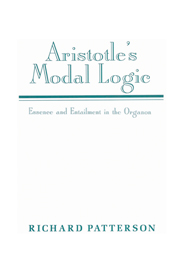Book contents
- Frontmatter
- Contents
- Acknowledgments
- Chapter 1 Introduction
- Chapter 2 The basic modal proposition
- Chapter 3 Syllogisms with two necessity premises
- Chapter 4 Mixed syllogisms: one assertoric and one necessity premise
- Chapter 5 Two-way possibility: some basic preliminaries
- Chapter 6 Two-way possibility syllogisms
- Chapter 7 Aristotle's perfect syllogisms
- Chapter 8 Principles of construction
- Appendix Categorical propositions and syllogisms
- Notes
- Select bibliography
- Index
Chapter 6 - Two-way possibility syllogisms
Published online by Cambridge University Press: 14 November 2009
- Frontmatter
- Contents
- Acknowledgments
- Chapter 1 Introduction
- Chapter 2 The basic modal proposition
- Chapter 3 Syllogisms with two necessity premises
- Chapter 4 Mixed syllogisms: one assertoric and one necessity premise
- Chapter 5 Two-way possibility: some basic preliminaries
- Chapter 6 Two-way possibility syllogisms
- Chapter 7 Aristotle's perfect syllogisms
- Chapter 8 Principles of construction
- Appendix Categorical propositions and syllogisms
- Notes
- Select bibliography
- Index
Summary
In chapters 14–22, Aristotle methodically considers all the various combinations of premise pairs involving at least one two-way possibility (“problematic” or “contingent”) premise. Chapters 14–16 take up firstfigure moods having, respectively, two problematic premises, one problematic and one assertoric premise, and one problematic and one necessity premise. Chapters 17–19 take up the same combinations, now in the second figure, and 20–22 carry the plan through the third figure. (For a chart of the ground plan of chapters 8–11 and 14–22, see the first page of Chapter 3 herein.) As with the necessity syllogisms of 8–11 and the assertoric ones of 4–6, Aristotle singles out the “complete” or “perfect” (teleios) moods, those whose validity is obvious on the basis of the premises precisely as given, and then validates other moods by reducing them to perfect moods by use of term or qualitative conversion or reductio ad impossibile, or by validating them through ekthesis. Some portions of these chapters are fairly routine and so will be presented here in summary fashion. This will leave us free to focus on a number of logical curiosities and on some significant philosophical issues, including that of the relation of these syllogisms to Aristotelian science.
TWO PROBLEMATIC PREMISES: FIRST FIGURE
All the perfect moods with this combination of premises fall into the first figure and correspond exactly to the four perfect plain moods of Pr. An. A.4. Thus, chapter 14 consists in a discussion of Barbara, Celarent, Darii, and Ferio pp, pp/pp, and of several invalid moods.
- Type
- Chapter
- Information
- Aristotle's Modal LogicEssence and Entailment in the Organon, pp. 145 - 205Publisher: Cambridge University PressPrint publication year: 1995



